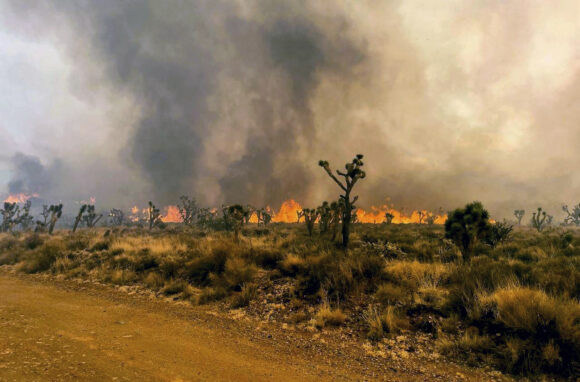PHOENIX (AP) — Phoenix sizzled through its 31st consecutive day of at least 110 degrees Fahrenheit (43.3 Celsius) and other parts of the country grappled Sunday with record temperatures after a week that saw significant portions of the U.S. population subject to extreme heat.
The National Weather Service said Phoenix climbed to a high of 111 F (43.8 Celsius) before the day was through.
July has been so steamy thus far that scientists calculate it will be the hottest month ever recorded and likely the warmest human civilization has seen. The World Meteorological Organization and the European Union’s Copernicus Climate Change Service on Thursday proclaimed July beyond record-smashing.
The historic heat began blasting the lower Southwest U.S. in late June, stretching from Texas across New Mexico and Arizona and into California’s desert.
On Sunday, a massive wildfire burning out of control in California’s Mojave National Preserve spread rapidly amid erratic winds, while firefighters reported progress against another major blaze to the south that prompted evacuations.
Crews battled “fire whirls” as the massive wildfire crossed into Nevada amid dangerously high temperatures and raging winds.
The blaze erupted Friday near the remote Caruthers Canyon area of the vast wildland preserve, crossed the state line into Nevada on Sunday and sent smoke further east into the Las Vegas Valley.
Wind-driven flames 20 feet (6 meters) high in some spots charred tens of thousands of acres of desert scrub, juniper and Joshua tree woodland, according to an incident update.
A fire whirl — sometimes called a fire tornado — is a “spinning column of fire” that forms when intense heat and turbulent winds combine, according to the National Park Service.
The vortexes — which can be anywhere from a few feet tall to several hundred feet high, with varying rotational speeds — were spotted Sunday on the north end of the York Fire.
“While these can be fascinating to observe they are a very dangerous natural phenomena that can occur during wildfires,” the park service wrote.
The blaze was about 20% contained on Monday. Crews expected to face limited visibility due to the fire`s thick smoke. The cause of the York Fire remains under investigation.
To the southwest, the Bonny Fire burned about 3.6 square miles (9.3 square kilometers) in the rugged hills of Riverside County.
More than 1,300 people were ordered to evacuate their homes Saturday near the community of Aguanga that is home to horse ranches and wineries.
One firefighter was injured in the blaze.
Gusty winds and the chance of thunderstorms into Tuesday will heighten the risk of renewed growth, the California Department of Forestry and Fire Protection said in a statement.
Triple-digit heat was expected in parts of the central San Joaquin Valley through Monday, according to the National Weather Service.
And in Burbank, California, about 10 miles (16 kilometers) north of Los Angeles, the summer heat may have been responsible for some unusual behavior in the animal kingdom: Police in the city responded to a report of a bear sighting in a residential neighborhood and found the animal sitting in a Jacuzzi behind one of the homes.
As climate change brings hotter and longer heat waves, record temperatures across the U.S. have killed dozens of people, and the poorest Americans suffer the most. Air conditioning, once a luxury, is now a matter of survival.
Last year, all 86 heat-related deaths indoors were in uncooled environments.
“To explain it fairly simply: Heat kills,” said Kristie Ebi, a University of Washington professor who researches heat and health. “Once the heat wave starts, mortality starts in about 24 hours.”
It’s the poorest and people of color, from Kansas City to Detroit to New York City and beyond, who are far more likely to face grueling heat without air conditioning, according to a Boston University analysis of 115 U.S. metro areas.
Back in Phoenix, slight relief may be on the way as expected seasonal thunderstorms could drop temperatures Monday and Tuesday.
“It should be around 108 degrees, so we break that 110 streak,” meteorologist Tom Frieders said. “Increasing cloud cover will put temperatures in a downward trend.”
The relief could be short-lived, however. Highs are expected to creep back to 110 F (43.3 C) Wednesday with temperatures reaching 115 F (46.1 C) by the end of the week.
Phoenix has also sweated through a record 16 consecutive nights when the lows temperature didn’t dip below 90 F (32.2 C), making it hard for people to cool off after sunset.
Meanwhile, Las Vegas continues to flirt with its hottest July ever. The city is closing in on its 2010 record for the average of the high and low each day for July, which stands at 96.2 F (35.5 C).
The extreme heat is also hitting the eastern U.S, as soaring temperatures moved from the Midwest into the Northeast and Mid-Atlantic, where some places recorded their warmest days so far this year.
Top photo: In this photo provided by the National Park Service Mojave National Preserve, the York fire burns in an area of the Mojave National Preserve on Saturday, July 29, 2023. A massive wildfire burning out of control in California’s Mojave National Preserve is spreading rapidly amid erratic winds. Meanwhile, firefighters reported some progress Sunday against another major blaze to the southwest that prompted evacuations. (Park Ranger R. Almendinger/ InciWeb /National Park Service Mojave National Preserve via AP)
Was this article valuable?
Here are more articles you may enjoy.


 OpenAI And Microsoft Sued Over Murder-Suicide Blamed on ChatGPT
OpenAI And Microsoft Sued Over Murder-Suicide Blamed on ChatGPT  JPMorgan Wins Gender Pay Gap Dispute Against London Analyst
JPMorgan Wins Gender Pay Gap Dispute Against London Analyst  Palantir Poaching Suit Called ‘Scare’ Tactic by Ex-Employees
Palantir Poaching Suit Called ‘Scare’ Tactic by Ex-Employees  Cyber Breach Affected 750,000 Canadian Investors, Regulator Says
Cyber Breach Affected 750,000 Canadian Investors, Regulator Says 